The cell and gene therapy market represents the forefront of medical innovation, offering transformative solutions for diseases that were once considered untreatable. With accelerated clinical activity, significant regulatory support, and strong investment inflows, CGT is evolving from niche biotechnology to a cornerstone of modern healthcare. The convergence of CRISPR gene editing, mRNA platforms, allogeneic cell therapies, and viral and non-viral vector technologies is redefining therapeutic delivery and enhancing patient outcomes globally.
The global cell and gene therapy market size is valued at USD 20 billion in 2025 and is expected to surge around USD 120.25 billion by 2034, expanding at a compound annual growth rate (CAGR) of 22.8% over the forecast period 2025 to 2034.
The cell and gene therapy market is driven by advancements in personalized medicine and an increasing number of FDA-approved therapies. The growing prevalence of chronic and genetic disorders such as cancer, rare inherited diseases, and autoimmune conditions has heightened demand for innovative treatments that go beyond traditional drugs. Governments and private organizations are investing heavily in research and development, further propelling the industry's expansion. In addition, technological innovations in manufacturing, such as automation and improved vector delivery systems, are reducing production costs and enhancing scalability. The cell and gene therapy market are also seeing significant activity in mergers, acquisitions, and collaborations among biotechnology companies, pharmaceutical giants, and research institutions, aiming to accelerate development and commercialization. Regions like North America and Europe dominate the market due to strong regulatory frameworks, advanced healthcare infrastructure, and early adoption of novel treatments.
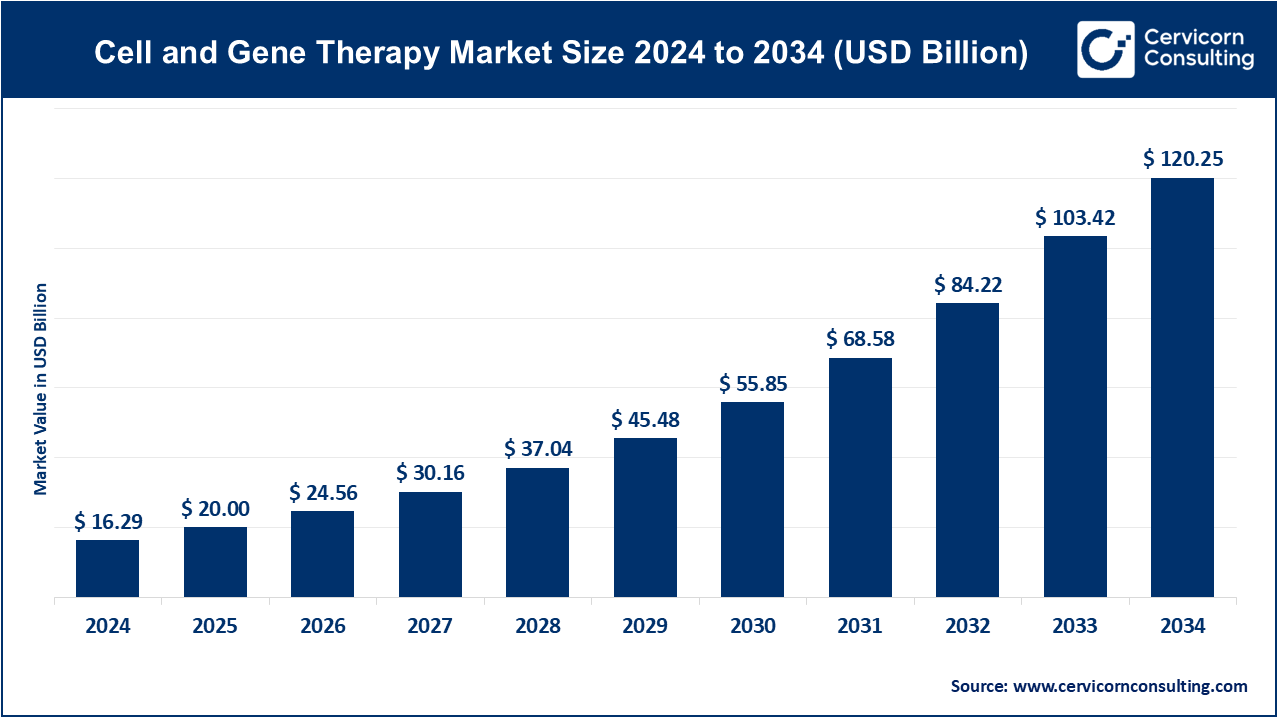
Cell and gene therapy are innovative medical treatments that involve manipulating cells or genetic material to treat or cure diseases. Cell therapy refers to the introduction of live cells into a patient's body to replace or repair damaged tissues or organs. Gene therapy involves the modification or insertion of genes into a patient's cells to treat or prevent disease, often targeting genetic disorders or cancers. Both therapies are considered cutting-edge treatments in the fields of oncology, genetic disorders, and regenerative medicine. They hold the potential to address previously untreatable conditions by repairing the root cause of the disease at a cellular or genetic level.
Emerging Global Trends in Cell and Gene Therapy
Corporate Strategy & M&A Highlights in the Cell and Gene Therapy Market
| Company | Deal/Action | Deal Type | Therapeutic Focus | Strategic Objective |
| Roche | Acquired Poseida Therapeutics (deal worth up to $1.5 billion) | Acquisition | Allogeneic CAR T (solid tumors, hematologic cancers) | Expand pipeline into off-the-shelf cell therapies and solid tumor immunotherapies |
| AstraZeneca | Entered into a $1 billion deal with EsoBiotec | Licensing + Strategic Stake | Off-the-shelf T-cell therapies | Strengthen position in cell therapy innovation for oncology |
| BioNTech | Acquired CureVac in an all-stock deal worth $1.25 billion | Acquisition | mRNA-based immunotherapies | Scale mRNA technology for oncology and infectious diseases |
| CRISPR Therapeutics + Vertex | Received FDA approval for exa-cel, the first approved CRISPR therapy | Regulatory Milestone | Sickle Cell Disease (Beta-Thalassemia) | Achieve first-in-class status in gene editing and rare disease |
| Catalent | Acquired MaSTherCell and Rheincell GmbH | Acquisition | Viral vectors, iPSC manufacturing | Expand CGT manufacturing capabilities and viral vector expertise |
Report Scope
| Area of Focus | Details |
| Market size in 2025 | USD 20 Billion |
| Market size in 2034 | USD 120.25 Billion |
| Market Growth Rate | CAGR of 22.8% from 2025 to 2034 |
| Largest Region | North America |
| Fastest Growing Region | Asia-Pacific |
| Segment Covered | By Therapy Type, Therapeutic Class, Delivery Method, End-Users, Regions |
Aging Population and Associated Diseases:
Development of Innovative Business Models:
Complex Regulatory Challenges:
Manufacturing and Scalability Issues:
Technological Integration with Artificial Intelligence (AI) and Machine Learning (ML):
Orphan Drug Designation and Market Exclusivity:
High Development and Treatment Costs:
Logistical and Supply Chain Complexities:
Cell Therapy: The cell therapy segement has dominated the market with the share of 86% in 2024. Cell therapy involves using living cells, either from the patient (autologous) or a donor (allogeneic), to treat medical conditions. It aims to replace damaged cells or stimulate repair. Recent trends show a focus on personalized treatments and advancements in manufacturing techniques to scale production.
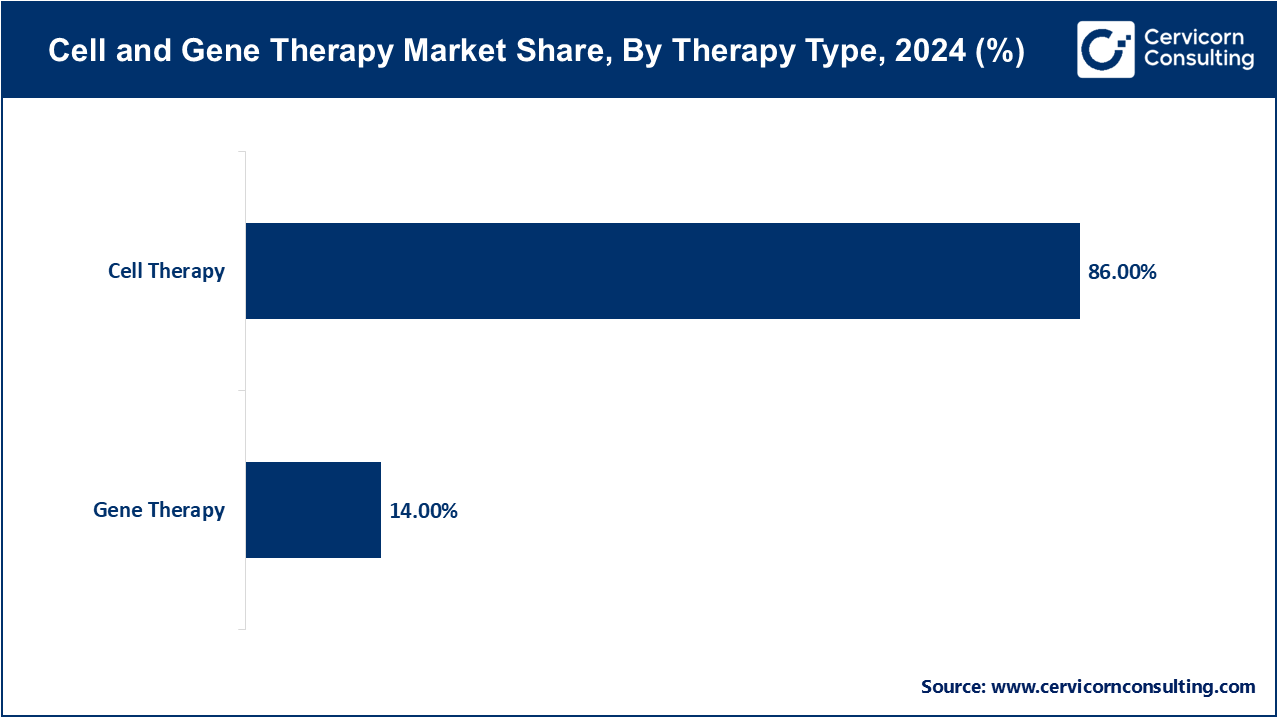
Gene Therapy: The gene therapy segment has covered market share of 14% in 2024. Gene therapy aims to treat or prevent disease by modifying a patient's genes. It involves introducing genetic material into cells to correct genetic disorders or enhance therapeutic effects. Current trends include the development of viral vectors for efficient gene delivery and regulatory advancements supporting commercialization.
Cardiovascular Disease: The cardiovascular disease segment has recorded market share of 4.86% in 2024. Therapies target heart conditions by repairing or replacing damaged tissues. Market trends show a focus on regenerative treatments for heart failure and vascular diseases, leveraging stem cell therapies and gene editing to enhance efficacy and patient outcomes.
Cancer: Addressing malignancies by modifying genes or immune cells to target and destroy cancerous cells. Advances include personalized therapies and targeted genetic modifications, supported by robust clinical trials and regulatory approvals driving market expansion.
Genetic Disorder: Thegenetic disorder segment has accounted market share of 10.64% in 2024. Treatments correct defective genes causing inherited conditions like cystic fibrosis. Market growth emphasizes precision medicine and gene editing technologies, with increasing investment in rare disease therapies.
Rare Diseases: Targeting conditions affecting a small population with genetic therapies. Market expansion is driven by orphan drug incentives, breakthroughs in gene editing, and growing awareness of rare disease treatments.
Oncology: The oncology segment has calculated market share of 12.55% in 2024. Focus on cancers, leveraging gene therapy to enhance immune responses or directly target tumors. Market trends highlight CAR-T cell therapies, viral vector advancements, and emerging immunotherapies, driving transformative changes in cancer treatment paradigms.
Hematology: The hematology segment has captured market shar of 7.78% in 2024. Treating blood disorders through gene therapy, including hemophilia and sickle cell disease. Trends include gene editing for blood stem cells, expanded clinical trials exploring curative therapies, and improved patient access.
Ophthalmology: The ophthalmology segment has achived market share of 5.40% in 2023. Correcting genetic defects causing vision loss, with treatments like gene supplementation or editing. Market growth seen in gene therapies for inherited retinal diseases, supported by advances in ocular delivery methods and regulatory approvals.
Infectious Disease: The infectious disease segment has considered highest market share of 28.70% in 2024. Targeting viral infections by modifying host cells or immune responses. Trends include gene-based vaccines, antiviral gene editing technologies like CRISPR, and advancements in viral vector design for efficient gene delivery.
Neurological Disorders: The neurological disorders segment has held market share of 4.26% in 2024. Addressing conditions like Alzheimer's and Parkinson's by modifying brain cells or enhancing neuroprotection. Market focus on gene therapy delivery methods, neuroregeneration techniques, and innovative clinical trial designs to tackle complex neurological challenges.
Others: The others segment has generated second highest market share of 25.81% in 2024. Includes diverse conditions from metabolic disorders to autoimmune diseases. Market growth driven by expanding gene editing applications, novel gene therapies targeting specific disease pathways, and collaborations between biotech firms and academic research centers to accelerate therapeutic development.
Hospitals: The Hospitals segment has covered market share of 27.73% in 2024. Hospitals play a critical role in the cell and gene therapy market, offering infrastructure for clinical trials and treatments, facilitating patient access to innovative therapies.
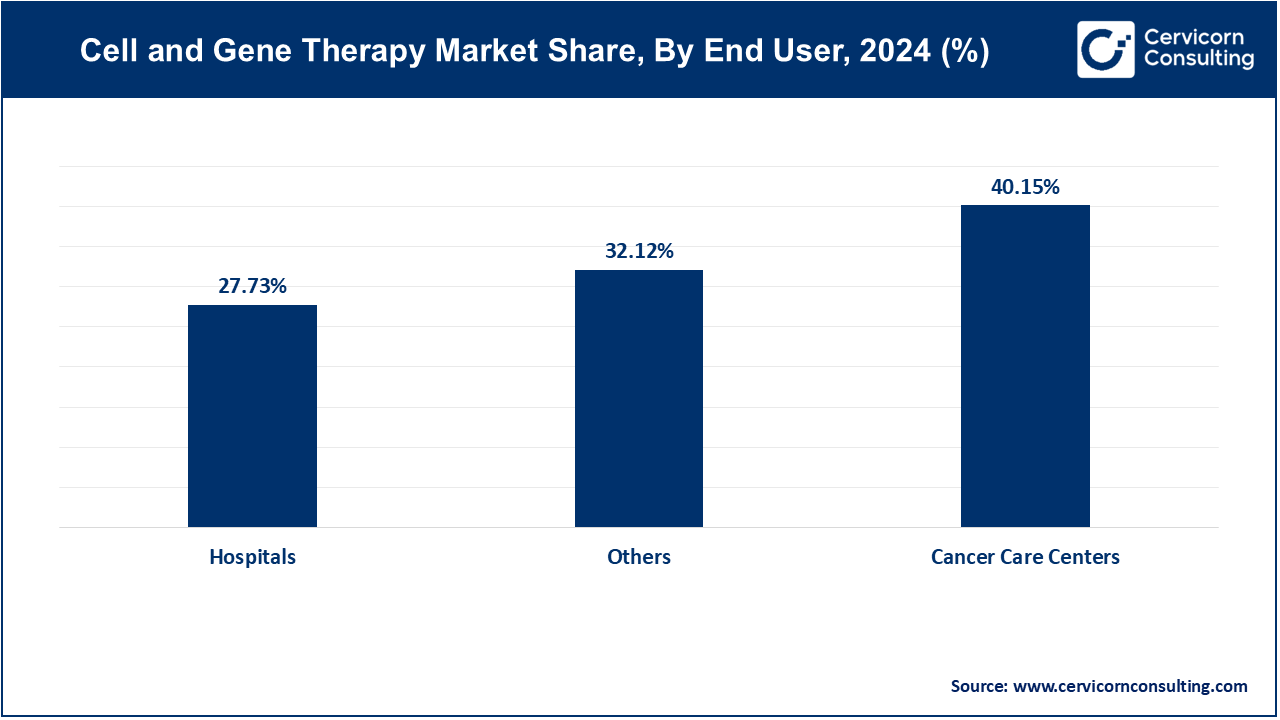
Cancer Care Centers: The cancer care centers segment has recorded markey share of 40.15% in 2024. These centers specialize in oncology, leading the adoption of personalized therapies such as CAR-T and gene editing to precisely target cancer cells, improving treatment efficacy and patient outcomes.
Wound Care Centers: Dedicated to chronic wound management, these centers integrate regenerative cell therapies to promote faster healing and tissue regeneration, addressing unmet medical needs with advanced treatment options.
Others: The others segemet has accounted market share of 32.12% in 2024. This category encompasses research institutions and biotech firms driving innovation in cell and gene therapies. They contribute to market growth through groundbreaking research, technological advancements, and regulatory developments, expanding treatment options and accessibility globally.
The North America market size is calculated at USD 8.15 billion in 2024 and is projected to grow around USD 60.12 billion by 2034. Known for robust regulatory frameworks and advanced healthcare infrastructure, North America leads in clinical trials and commercialization of cell and gene therapies. Significant investments in biotech and pharmaceutical sectors drive innovation, focusing on oncology and rare diseases.
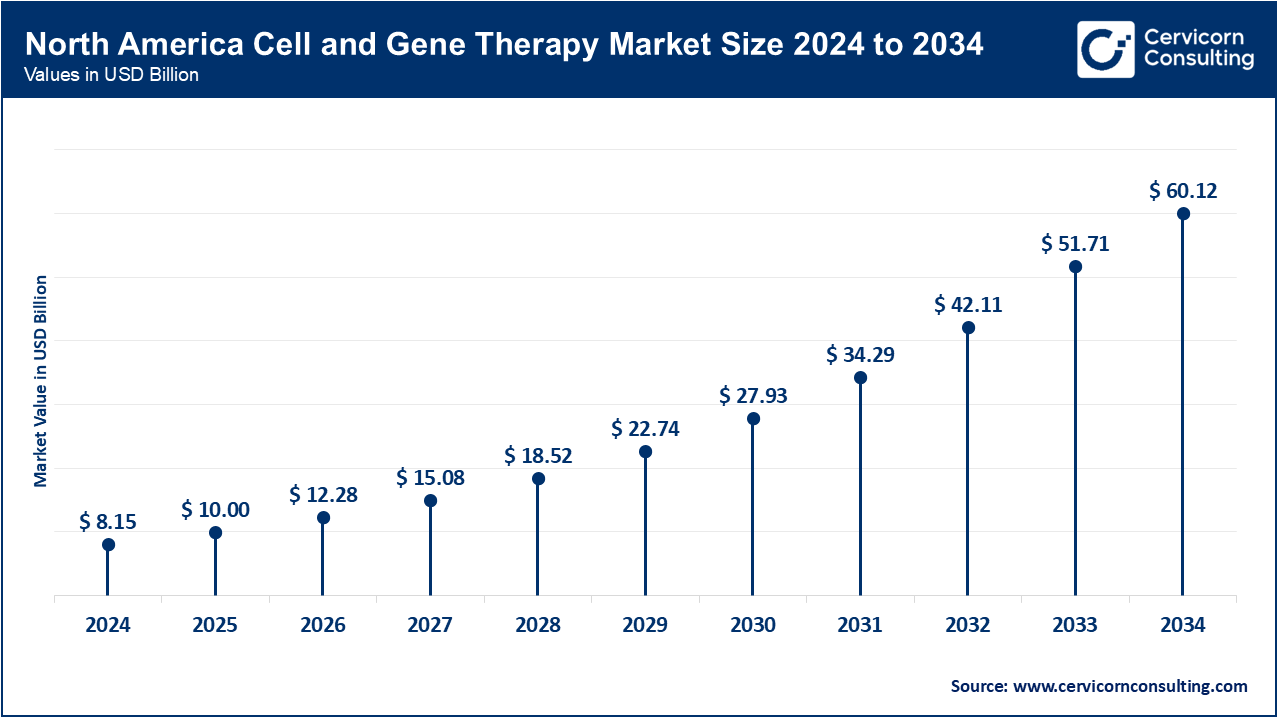
Europe emphasizes collaborative research initiatives and regulatory harmonization, fostering a competitive landscape for cell and gene therapies. Europe market size is predicted to hit around USD 31.27 billion by 2034 from USD 4.24 billion in 2024. Countries like the UK, Germany, and Switzerland are prominent in biotech innovation and clinical development, with a focus on expanding treatment options for genetic disorders.
Rapidly evolving healthcare systems in countries like China, Japan, and South Korea drive growth in the Asia-Pacific region. Asia Pacific market size is expected to reach around USD 21.65 billion by 2034 increasing from USD 2.93 billion in 2024. Increasing investments in biopharmaceuticals and supportive regulatory reforms accelerate the adoption of cell and gene therapies, particularly in oncology and regenerative medicine.
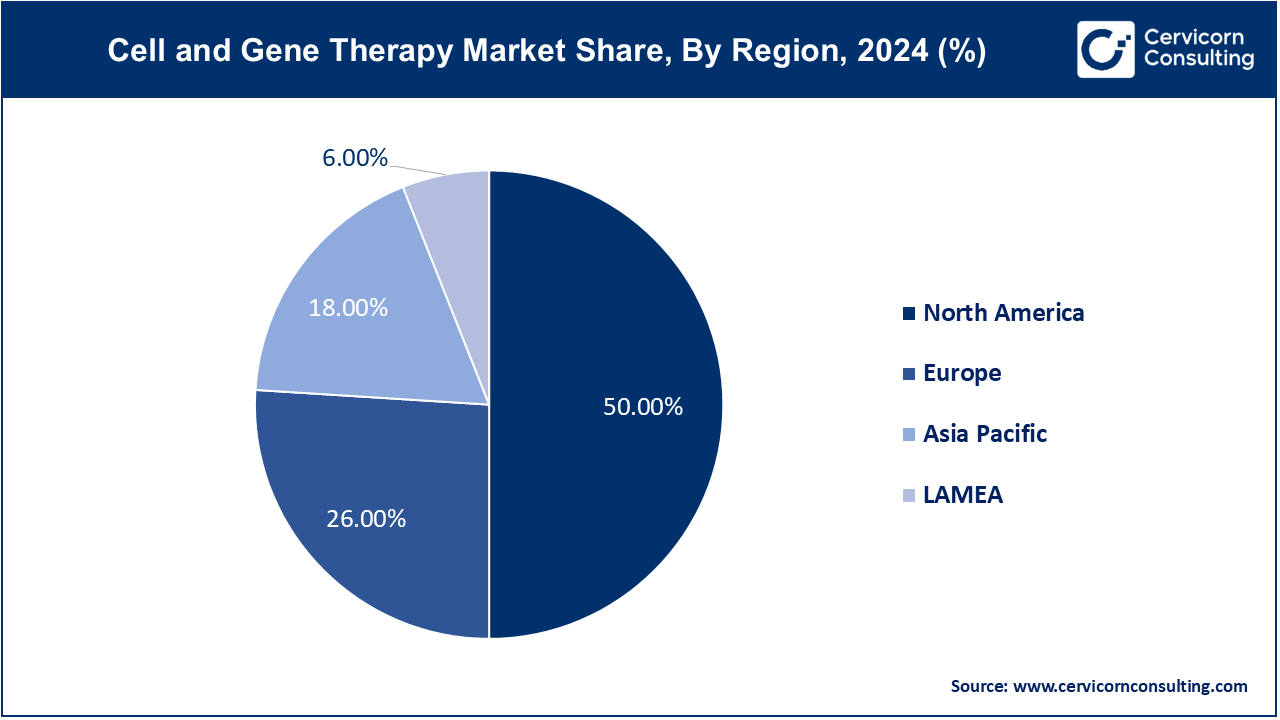
The LAMEA market size is calculated at USD 0.98 billion in 2024 and is anticipated to reach around USD 7.22 billion by 2034. Emerging markets in LAMEA are witnessing a gradual uptake of cell and gene therapies, supported by improving healthcare infrastructure and rising healthcare expenditure. Focus areas include genetic disorders and infectious diseases, with growing investments in biotech and partnerships with global pharmaceutical firms.
New players like CRISPR Therapeutics, Intellia Therapeutics, and Fate Therapeutics have adopted innovative gene editing technologies, advancing their entry into the cell and gene therapy market. These companies focus on precision medicine and novel therapeutic approaches, attracting investment and partnerships. Key players dominating the market include established pharmaceutical giants like Novartis, Gilead Sciences, and Bristol-Myers Squibb, leveraging extensive R&D capabilities, global reach, and regulatory expertise. They lead through strategic acquisitions, pipeline expansions, and successful commercialization of therapies such as CAR-T treatments and gene therapies, reinforcing their market dominance and shaping industry standards.
Market Segmentation
By Therapy Type
By Therapeutic Class
By Delivery Method
By End-Users
By Regions